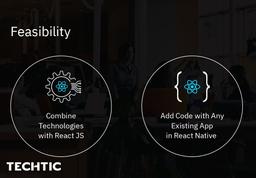React Native Vs React: Compare ReactJS and React Native in Detail
Sector: Technology
Author: Abhishek Singh
Date Published: 05/01/2019

Contents
React Native and React (also known as ReactJS), apart from owing their existence to Facebook have one more thing in common – JavaScript. Both pride themselves on the progressive technology that drives mobile and web respectively.
What is ReactJS?
ReactJS is a JavaScript library that helps simplify the development process, build high-performing ReactJS web apps and help deliver impeccable UIs.
What is React Native?
React Native on the other hand is a popular mobile app development framework used by mobile app developers to build Android and cross-platform applications.

Also referred to as an extension of ReactJS, the main focus of the React Native framework is the user interface, visual effects, and its immaculateness. React Native has in the past few years emerged as the most sought-after mobile application development framework by 1000s of businesses worldwide from Facebook, Instagram, Bloomberg, Skype, Soundcloud Pulse, Pinterest, and Airbnb to name a few.
React Native Vs. ReactJS: The Difference
Let's Talk - Efficiency

‘Both’React Native or ReactJS Enhances Developer Efficiency
Looking to build beautiful user interfaces for your business? ReactJS is the JavaScript library that does that for you. One of the unique features of ReactJS is that it can function together interoperable, i.e. it can perform on the client-side while being rendered on the server-side. So, what do you get out of it?
ReactJS helps you enhance developer efficiency but also empowers them with the added opportunities to utilize while making basic abstractions. Simply speaking, it is equally valuable for lower-level parts like clickable buttons and higher-level parts like dropdowns.
However, for React Native, a different approach is adopted to maximize developer efficiency. Components you would use in Android or iOS have counterparts right in ReactJS to get the same look and feel. Reusable native components compile directly to native that forms the building blocks in React Native. Here the app will have the look, speed, and functionality of a native mobile app that makes React Native unique and STAND OUT from other mobile app development frameworks.
Moreover, the React Native framework also allows highly experienced engineers to add native codes (Java, Swift, Objective-C, etc.) to the framework, to help achieve that custom look.
The success and the future of React Native are very much secured with these simple words of realization from the Facebook founder – clearly giving direction to the many advantages of building mobile apps using React Native framework.
Let's Talk – Feasibility

1. Combine Technologies with ReactJS
React or ReactJS combines technologies, where HTML and JavaScript, come together continually. Now, it is also concluded that this is done mainly to include CSS, which rejects a bunch of issues identified with CSS development, such as worldwide namespace, and variable/scope isolation.
2. Add Code with Any Existing App in React Native
Are you looking to add more to your existing app, but not prefer to change the code of the whole app? React Native can help make it possible for your business. You can just add React Native components into your existing app’s code. And in case your current hybrid app was built with Ionic and Cordova, you can reuse that Cordova-based code effectively with just a plugin.
Let's Talk – Capability and Prowess

1. Boost SEO for Web App with ReactJS
ReactJS is was designed to keep Search Engine Optimization (SEO) in mind, wherein it uses Node to render on the server of the user. Although there are similar tools to give this server viewpoint to rendering, they usually call for a ton of unstable hacks. This is apart from the extensive amount of developer support that is required for maintenance.
2. Build Responsive UI with React Native
React Native, on the other hand, is exclusively dedicated to building a mobile UI. This means, besides being completely UI-centred React Native makes for more like a JavaScript library rather than a framework. Hereby, the resultant UI is remarkably responsive and delivers a much smoother feel to the apps and speedier load times.
Let's Talk – How it Works?

What works behind the scene for both of these amazing technologies – ReactJS and React Native is what everyone wants to know. While React Native makes use of native APIs to render UI parts that can be reused over and again on both iOS and Android platforms, ReactJS harnesses the power of the virtual DOM (Document Object Model) to create better UX.
1. Virtual DOM for ReactJS
DOM, as you know, is about the logical structure of documents and the way it is accessed and manipulated. However, it takes time to build one and DOM trees nowadays are large. But, when you use ReactJS, it manages to accomplish this procedure faster and seamlessly by utilizing a virtual DOM that helps in making quick updates, while creating dynamic UIs. ReactJS does it by simply making use of an abstract copy of the Document Object Model, making the required changes to the one component’ and that too sans influencing the rest of the UI.
2. Native APIs for React Native
On the other hand, React Native uses Objective-C APIs to write iOS components and Java APIs to render Android components. Thereafter, JavaScript is utilized to compose whatever remains of the code and customize the app for every platform – ensuring maximum reusability of the components and shareability of codes.
While ReactJS uses HTML and CSS, React Native does not. You will have to create style sheets in JavaScript to style your ReactNative components, which even though may look similar to CSS, are not close to the same. Similarly, ReactJS uses <p> against <text> in React Native, while <div> in React is used instead of<view>for React Native. Here is an example to show the same:
- For ReactJS

- For ReactNative

Protip: To run your app built with React Native, you will need to have Android Studio (for Android) or Xcode (for iOS, on Mac only) installed on your computer. Thereafter, you can either decide to run it on a simulator/emulator of the platform of your choice or directly on your own devices.
Conclusion
It is great fun using both ReactJS and ReactNative tools. Developers who are adept at ReactJS have an edge, as they can also build great applications in React Native. React Native is damn fast and takes 33% less time than building an Android or iOS app natively. It allows you to build complex UI as quickly as you would do with ReactJS that works quite well for both iOS and Android. Another great thing about working with ReactNative is that it allows the use of most developer tools (such as Chrome Dev Tools, Redux DevTools, etc) used with ReactJS. That’s why React Native app development can reduce the mobile app development cost.
Are you looking to build a web app using ReactJS or an impeccable mobile application using the React Native framework? Talk to our experts for suggestions and solutions.



